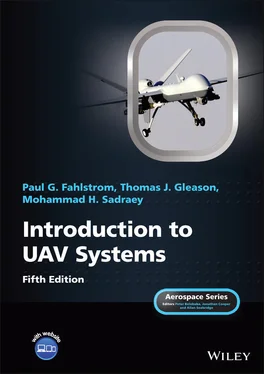Long range: This class of UAVs was not defined by JPO. However, an endurance UAV is capable of flying in a long range (e.g., thousands of miles) mission.
This classification system has been superseded. However, some of the terminology and concepts, particularly the use of a mix of range and mission to define a class of UAVs, persist today and it is useful for anyone working in the field to have a general knowledge of the terminology that has become part of the jargon of the UAV community.
The following sections outline some of the more recent terminology used to classify UAVs. Any government‐dictated classification scheme is likely to change over time to meet the changing needs of program managers, and the reader is advised to search the literature and other references if the current standard of government classification is needed. Operation and certification of small unmanned aircraft systems is regulated [5] by Federal Aviation Administration under Part 107.
2.2.3 Classification by Missions
Defining the missions for UAVs is a difficult task because (1) there are so many possibilities and (2) there have never been enough systems in the field to develop all of the possibilities. This is not to say that the subject has not been thought about, because there have been repeated efforts to come up with comprehensive lists as part of classification schemes. All such lists tend to become unique to the part of the UAV community that generates them, and all tend to become out of date as new mission concepts continually arise.
Two major divisions of missions for UAVs are civilian and military, but there is significant overlap between these two in the area of reconnaissance and surveillance, which a civilian might call search and surveillance or observation, which is the largest single application of UAVs in both the civilian and military worlds.
The development of UAVs has been led by the military and there are other areas long recognized as potential military missions that also have civilian equivalents. These include atmospheric sampling for radiation and/or chemical agents, providing relays for line‐of‐sight communications systems, and meteorological measurements.
An area of interest to both the military and civilian worlds is to provide a high‐altitude platform capable of lingering indefinitely over some point on the Earth that can perform many of the functions of a satellite at lower cost and with the capability of landing for maintenance or upgrade and of being re‐deployed to serve a different part of the world whenever needed.
Within the military arena, another division of missions has become prominent during the last decade. An increasing mission for military UAVs is the delivery of lethal weapons (i.e., precision strike). This mission has a number of significant distinctions from nonlethal missions in the areas of AV design and raises new issues related to the level of human control over the actions of the AV.
Of course, all missiles are “unmanned aerial vehicles.” However, we consider systems that are designed to deliver an internal warhead to a target and destroy themselves while destroying that target as flying weapons (e.g., a missile), and distinguish them from vehicles that are intended to be recoverable and reused for many flights (i.e., UAV). As discussed later in this book, although there are areas in common between flying weapons and reusable aircraft, there are also many areas in which the design tradeoffs for weapons differ from those for the aircraft.
As of this writing, the primary form of active armed UAV is an unmanned platform, such as the MQ‐1 Predator (see Figure 11.1) and MQ‐9 Reaper (see Figure 1.5) carrying precision‐guided munitions and the associated target acquisition and fire‐control systems such as imaging sensors and laser designators. This is evolving to include the delivery of small guided bombs and other forms of dispensed munitions. These systems can be considered unmanned ground attack aircraft and unmanned combat aerial vehicle (UCAV). The future seems to hold unmanned fighters and bombers, either as supplements to manned aircraft or as substitutes.
DOD and Boeing have – in the past few years – developed and tested a number of UCAVs such as Boeing X‐45, Northrop Grumman X‐47, and Kratos XQ‐58 Valkyrie. Moreover, some European countries are currently developing UCAVs. Under development are: BAE Corax (also known as Raven), EADS Barracuda (Germany), Dassault nEUROn (France), Elbit Hermes 450 (Israel), BAE Taranis (UK), Boeing X‐45A, and EADS Surveyor (Multinational). Furthermore, Chengdu Wing Loong (Chinese title, GJ‐2) – a long range UAV with a strike capability and a satellite data link – has been developed by China in 2018.
There is an ambiguous class of military missions in which the UAV does not carry or launch any weapons, but provides the guidance that allows the weapons to hit a target. This is accomplished using laser designators on the AV that “point out” the target to a laser‐guided weapon launched from a manned aircraft or delivered by artillery. As we have seen, this mission was a primary driver for the resurgence of interest in UAVs in the US Army in the late 1970s. It remains a major mission for many of the smaller tactical UAVs in use by the military.
The classes of UAVs – Close‐Range, Short‐Range, Mid‐Range, and Endurance – imply missions by virtue of their names, but the services often employ them in such unique ways that it is impossible to say that there is only one mission associated with each name. For example, the Air Force’s airfield battle damage assessment mission and the Army’s target designation mission both could utilize similar airframes (e.g., having the same weight and shape), but would require an entirely different range, endurance, speed, and payload capabilities. Some missions appear to be common to all the services such as reconnaissance, but the Army wants “close” reconnaissance to go out to 30 km, and the Marine Corps believes that 5 km is about right.
Among the core missions of UAVs for both military and civilian use are ISR, Intelligence, Surveillance, and Reconnaissance (search), which often are combined, but are different is important ways, as seen in the following definitions:
Intelligence: The activity to obtain – by visual or other detection methods – information about what is present or happening at some point or in some area.
Surveillance: The systematic observation of aerospace, surface or subsurface areas, places, persons, or things by visual, aural, electronic, photographic, or other means.
Reconnaissance: The activity to identify a target (e.g., individual, car, or building) by visual or other detection methods at some point or in some area via comparing the obtained information with the reference data.
Thus, surveillance implies long endurance and, for the military, somewhat stealthy operations that will allow the UAV to remain overhead for long periods of time. Because of the interrelationship between intelligence, surveillance, and reconnaissance, the same assets are usually used to accomplish all three missions.
Insitu ScanEagle missions include ISR, as well as special services operations, escort operations, sea‐lane and convoy protection, protection of high‐value and secure installations, and high‐speed wireless voice, video, and data communications relay.
These missions imply the detection and identification of stationary and moving targets both day and night – quite a formidable task, as we will see when discussing payloads and data links. The hardware requirements for the detection and identification capabilities impact almost every subsystem in the air vehicle as well as the ground station. Each UAV user may have requirements for the range from the UAV base to the area to be searched, the size of the area that must be searched, and the time on station required for surveillance, so intelligence/surveillance /reconnaissance missions and hardware can vary significantly.
Читать дальше












